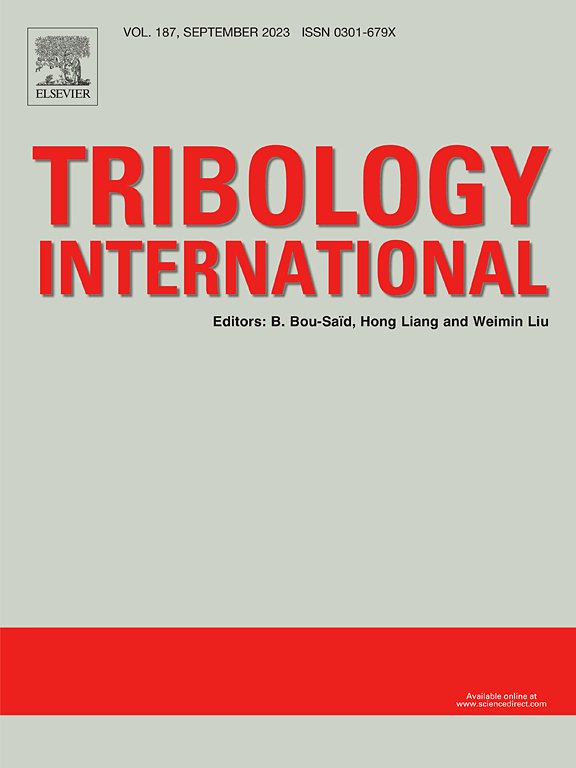增强相B2和Ti5Si3的梯度分布使钛合金摩擦腐蚀优化
IF 6.1
1区 工程技术
Q1 ENGINEERING, MECHANICAL
引用次数: 0
摘要
通过电磁悬浮耦合落铸(EML-FC)技术控制了 Ti-Al-Mo-Si 合金中 Ti5Si3 和 B2 相的分布。与合金中的其他成分相相比,作为强化相的 B2 和 Ti5Si3 相具有更好的耐磨性、钝化和再钝化能力。由于 Mo 和 Si 含量的增加,Ti50Al42Mo4Si4 合金中这两相的体积分数高于 Ti50Al46Mo2Si2 合金。这两种相的分布可通过 EML-FC 工艺进一步控制,形成合金中从边缘到中心体积分数增加的梯度分布。这有利于快速形成致密的钝化膜,并使合金的梯度腐蚀行为有效地防止整个合金被腐蚀。EML-FC 在 Ti50Al42Mo4Si4 合金表面形成的致密钝化膜与磨损碎屑混合,并在合金表面形成摩擦膜,从而在摩擦腐蚀过程中为基体提供更有效的保护和润滑。此外,Ti50Al42Mo4Si4 合金中 B2 和 Ti5Si3 相体积分数较高的梯度分布显著抑制了合金基体的拔出,使 Ti5Si3 和 B2 相被氧化以减少对基体的磨损,并有效提高了摩擦腐蚀条件下的再钝化能力。因此,Ti-Al-Mo-Si 合金的耐腐蚀性和抗摩擦腐蚀性得到了改善。本文章由计算机程序翻译,如有差异,请以英文原文为准。
Gradient distribution of reinforced phases B2 and Ti5Si3 enabling tribocorrosion optimization in titanium alloy
The distribution of Ti5Si3 and B2 phases in the Ti-Al-Mo-Si alloys was controlled via electromagnetic levitation coupled with fall casting (EML-FC) technique. The B2 and Ti5Si3 phases as reinforced phases exhibited improved wear resistance, passivation and repassivation capability compared to other constituent phases in the alloy. The volume fraction of these two phases in the Ti50Al42Mo4Si4 alloy was higher than that in the Ti50Al46Mo2Si2 alloy owing to the increase of Mo and Si content. The distribution of these two phases can be further controlled by the EML-FC process to form the gradient distribution with increasing volume fraction from edge to center in alloys. This facilitated the rapid formation of a dense passivation film and caused the gradient corrosion behavior of the alloys to effectively prevent the entire alloy from being corroded. The denser passivation film on the surface of Ti50Al42Mo4Si4 alloy by EML-FC mixed with wear debris and formed a friction film on the alloy surface to provide more effective protection and lubrication for the matrix during tribocorrosion. Moreover, the gradient distribution with the higher volume fraction of B2 and Ti5Si3 phases in the Ti50Al42Mo4Si4 alloy significantly restrained pulling out of the alloy matrix, caused Ti5Si3 and B2 phases to be oxidized to reduce wear on the matrix and effectively enhanced repassivation ability under tribocorrosion condition. Consequently, the corrosion and tribocorrosion resistances of the Ti-Al-Mo-Si alloys were improved.
求助全文
通过发布文献求助,成功后即可免费获取论文全文。
去求助
来源期刊

Tribology International
工程技术-工程:机械
CiteScore
10.10
自引率
16.10%
发文量
627
审稿时长
35 days
期刊介绍:
Tribology is the science of rubbing surfaces and contributes to every facet of our everyday life, from live cell friction to engine lubrication and seismology. As such tribology is truly multidisciplinary and this extraordinary breadth of scientific interest is reflected in the scope of Tribology International.
Tribology International seeks to publish original research papers of the highest scientific quality to provide an archival resource for scientists from all backgrounds. Written contributions are invited reporting experimental and modelling studies both in established areas of tribology and emerging fields. Scientific topics include the physics or chemistry of tribo-surfaces, bio-tribology, surface engineering and materials, contact mechanics, nano-tribology, lubricants and hydrodynamic lubrication.
 求助内容:
求助内容: 应助结果提醒方式:
应助结果提醒方式:


